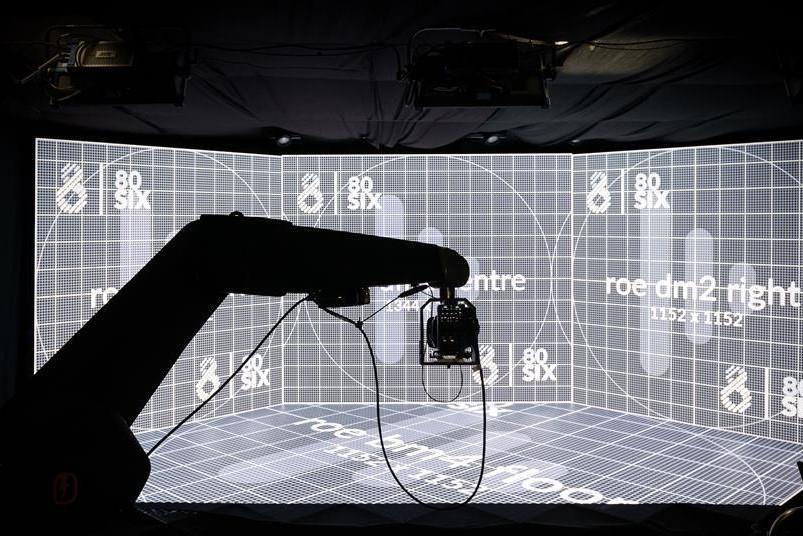With its Rapid Industry Solutions program for virtual production, SMPTE has become a devoted follower of technical fashion. It was a huge session on VP and another on how filmmakers can leverage Blockchain and NFTs which amplified the new image. But Andy Rayner, CTO of Nevion, also delivered an excellent presentation on where IP is taking us, while speakers’ constant references to the severe skills shortage plaguing the industry sparked conversations about the networking.
Rayner looked at what content producers want. “There is a desire to increase the value of production. There is a desire to reduce costs. In these two areas and in many other ways, there is a desire for more flexibility in the way we work,” he said.
“Almost everything we’re starting to do technologically actually meets these key requirements. It’s not just an intellectual property issue, it’s a computer issue. Broadcasting in general is moving from bespoke to generic,” he added. “What lies ahead is the move to virtualized infrastructure, or abstract infrastructure, different payment models, and convergence with NLE file-based tools.”
The other key development is moving users away from the technology. “People shouldn’t need to know high-tech, low-level computing broadcast principles to be able to use technology, so abstraction is really important. The same goes for leveraging the best security principles of basis of the computer industry.
Give them a photorealistic look
Brilliantly led by VP Christina Nowak’s director Anna Valley, paired sessions on virtual production and next-gen cinematography featured VP supervisor and on-set facility owner Asa Bailey and Phil Galler, CTO of NEP Virtual Studios, and Andrew Wilding, Vice President EMEA. sales with Sohonet respectively.

Nowak said, “VP has become a very hot topic since the pandemic, and it’s escalated again.”
Bailey admitted he came across VP by surprise. “We were taking real-time virtualization on set and didn’t know we were on the path to what became known as VP. Computing was totally off limits, so we developed specialty computing required and we sell it to artists and some of the biggest studios in the world.
“We differ from VFX supervisors because supervising VPs is more about coaching and helping activate each production department. We now work with a lot of still photography in environments, and find ourselves abandoning the techniques needed to capturing those things and feeding them into the engines. Then how to make them look photorealistic. But what looks realistic on a screen isn’t what looks realistic in a camera. We’re in a learning zone right now.
“There’s a lot of focus on technology, but at the end of the day, we’re filmmakers and we want to tell better stories…”
“The first to learn about this new storytelling technology are storytellers, and ads start latching onto VP pretty quickly. Because you could sell a concept in a conference room and still find a way to do it,” said he added.
Ad tech is the big driver
Galler has overseen and produced many projects and his goal is to intervene early and communicate across departments to ensure everyone understands the challenges.
“There’s a lot of focus on technology, but at the end of the day, we’re filmmakers and we want to tell better stories. We also want to empower other people to tell better stories. The best way to achieving this is to communicate clearly and [to] designing and innovating tools to allow people to see things as soon as possible,” he said. “It is the innovation of the pre-screw.”

The worst thing you could do, Galler said, was to integrate technology into a project after it started. “From a line-item perspective, VP takes a chunk out of the VFX budget, so it would be good to see a new VP production department with its own budget and line-items,” he added. “I try to connect film producers with producers who work in live television.”
Galler wants to see robust services and robust data management. He says, “The demand is rapidly outstripping our ability to handle large-scale remote manipulation. It’s not a matter of if but when things get real time. There’s no getting around it, and real-time advertising will drive the market, because there’s an immediate financial gain in getting real-time targeted ads. Ad technology ultimately drives nearly everything we do. »
He also wants to see the VP community bully the VFX business away from its old pipelines. Sohonet’s Wilding posed the tough question. “One of the challenges right now is that VP isn’t cheap. But if you’re shooting in a VP environment you save on all the carbon of stealing everyone to say New Zealand. We have to look at the impact carbon of the staff we’re putting in, and if we’re putting in 400 LED panels, what’s the power consumption, plus what’s the cost of all that rendering capability?
“What we’re also seeing with VP is that people don’t recognize that you’re creating so much data,” he added.
Galler also said, “We don’t move that much data, but what we have are really late deliveries that are really important and I need as big a pipeline as possible to pull that as quickly as I can. can deal with them. Now I ask for a designated 100 Gig.
Bailey added to that, “There’s something like a two-way struggle between the amount of data we’re creating, and we’re very aware of that.”
Keeping our rights with the blockchain
Reclaiming rights and making money were touted as the clear benefits of turning to blockchain and NFTs by Tracie Mitchell, MD of Greenfish.io and Solene Marvian, Producer at Film Angels.
They took turns getting things done, and Marvian started by saying, “I incorporated [blockchain and NFTs] in the manufacturing and distribution processes, because I think it will make it easier for independent producers.
“Media companies will end up banking broadcast services that they will sell. They will end up being just a wallet.
“NFTs are an additional way to find funding and retain our rights, and using blockchain could be a digital ledger that keeps track of all data transactions,” she added. “Once we have created a community, we can engage and share our project from the start. Even if we don’t manage to raise a full budget with NFTs alone, it gives us more leverage to reach out to other financiers.
What are the advantages of buying NFTs to finance a film? “The premiere could be a one-on-one session with one of the actors. It could be a credits mention or product placement in the film. The NFT I’m most excited about is whoever holds royalty income,” Marvian said. “Rights automation helps to redistribute revenue more efficiently after each sale, and we can use NFTs during distribution, which gives us a new and different opportunity to engage with our audience.”
Will media companies simply become a wallet?
Mitchell spent more than 25 years in broadcast engineering, but eventually found that every TV station she built “would be a bit of a cookie cutter.” She now builds applications on blockchain networks.
“There is a new industry that has emerged on standards, security and protocols to move media between A and B, and it completely ignores the value of media, and all financial data is reconciled after the fact” , she said. said. “Now producers are starting to engage directly with their audience and that audience is moving further upstream in our world and starting to be associated with the actual content.
“We hear all these terms – Web3, Film3, Metaverse, etc. – and we don’t know what it is. In my opinion, this is the biggest change in the global business model that we will see in our lifetime,” she added. “Media companies will end up banking broadcast services that they will sell. They will end up being just a wallet.
Mitchell thinks it’s time to look at different technologies and verticals, which means networks. She breaks down the future into wallet, smart contracts and network.
“We just transact with a wallet on the networks, and all tokens will be associated with that wallet; these will be security, utility, and a brand new one that I’m excited about called a soul-based token. Smart contracts are essentially your policies and rules,” she said.
The preferred network of the two speakers is the Blockchain Eluvio because it has a native stack. At the end of a demo around modular applications she had built directly and directly read a content file from the Internet, Mitchell said: “No database, and no moving files from A to B. That’s what new technology allows us to do. , and we can distribute content globally using these types of networks. It’s extremely clever. Smart contracts = power.

